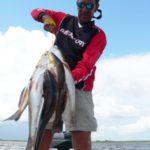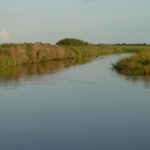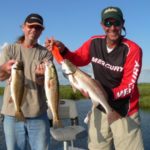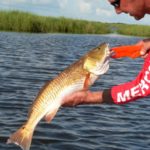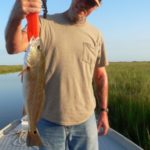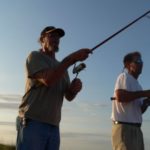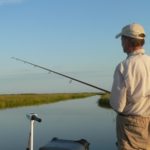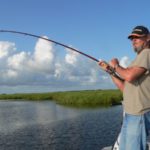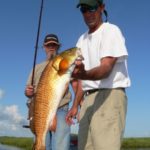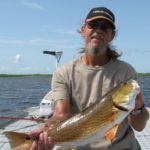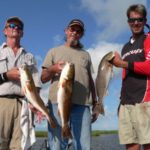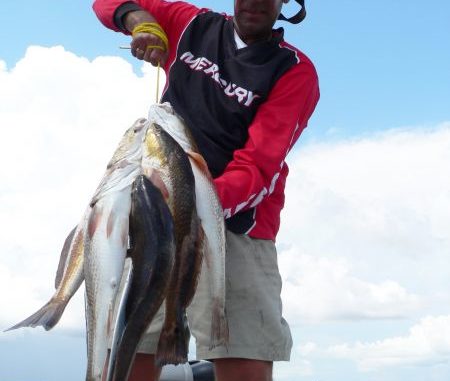
Lafitte’s Indian Graveyard is said to be haunted. Certainly a lot of redfish lurk around the burial mound — Just be careful not to spook them!
So, when the voice on the other end of the phone said we’d be fishing in a graveyard, I’ll admit it took me aback. The call came a short time before Hurricane Isaac struck, so we weren’t talking about fishing a flooded cemetery.
“Where are we going to be fishing?” I asked for clarification.
“Indian Graveyard,” the voice answered. “It’s a big area of ponds and canals down between here and Grand Isle.
“And it should be loaded up with redfish right now.”
The voice was that of Capt. John Pounders, who has been operating Eccentric Charters (504-382-2268) out of Lafitte for quite a few years. Over those years, I’ve fished with John for everything from offshore king mackerel to inshore species, but this sounded intriguing.
We agreed to meet at his lodge next to the SeaWay Marina in Lafitte, and loaded our gear aboard Pounder’s brand new 27-foot Kenny Landry custom-built aluminum bay boat.
Landry built hundreds of custom aluminum boats in the past but quit the business several years back. Pounders, however, managed to persuade him to un-retire long enough to build him this 27-foot double-console custom, and we settled in behind the full windshield for the long ride to the Graveyard.
Indian Graveyard is marked on Standard Mapping’s No. 340, and I figure its every bit of a 25-mile run from the marina. On the map, it’s just west of Hackberry Bay and Live Oak Bay.
The area is huge, about 2 miles square and covering a vast array of large and small marsh ponds, along with no-name canals that meander in all directions. I could see that one could quickly become lost and disoriented in the confusing maze of waters, but I could also see that this was prime territory for redfish.
“I fish here a lot,” Pounders said, “and it can still be confusing, so you know that someone unfamiliar with the area should use caution. Some of the canals and ponds are very shallow, holding only a few inches of water, and the deep ones are full of underwater stumps. This is definitely an area best fished with a shallow-draft boat like this aluminum one, but I also come fish in here with my Triton Bay Boat.
“Whatever your boat, this is just not an area to come roaring through or you’ll likely bend a prop or lose a lower unit.”
But Pounders said those who exercise the necessary caution and dare to venture into the area will be amply rewarded with all the redfish action they can handle.
Indian Graveyard is so named because, according to local legend, the Native Americans who formerly occupied this swath of Louisiana’s coastline buried their dead there in burial mounds. There is a high ridge lined with brush and scrub oak from which a burial mound is visible. There are numerous such mounds not only in the Lafitte area, but across the Gulf shoreline from Texas to Florida, where for a thousand years or more quite a number of tribes roamed the coast.
Atakapa, Caddo, Tunica, Natchez, Chitimach and Muskogee all lived in Louisiana, and each had their own particular area and language. All were at least somewhat nomadic, living off of Louisiana’s abundance of fish, oysters, crab, shrimp and the vast variety of wildlife.
The Native Americans quickly learned that burying their dead below ground was almost impossible in the soggy marshland, so mounds were built of substantive dirt and shells, and then their dead were entombed within.
The fact that the mounds still exist after all these years is mute testimony of their ingenuity. Not much stands for long in the Louisiana marsh!
Like all burial places, the Indian mounds possess a certain sanctity, a quietness and stillness you’d expect at a graveside. And there are many legends of hauntings and spectral sounds and appearances attached to the mounds. Some of the locals have said it’s positively eerie around them at night. When the night is dark and the wind is still, and the air is thick with humidity, you can almost hear unintelligible voices coming from the marsh. Reports of muted laughter, and something akin to the ghostly glow of a campfire flickering against the night blackness are not uncommon in the region.
Ghost stories aside, I know for a fact that the area is haunted: not by redskins, but by redfish!
That became immediately evident almost from our first cast that morning.
Pounders maneuvered the big aluminum boat through a virtual maze of ponds, and then glided to within casting distance of a prominent point. Our goal was to catch as many redfish as we could, and when that is your goal, the tactic is clear.
“Find clear water, anchor off a point where good current flows around it, and fish with the freshest bait you can get,” Pounders said.
On our way down he found bait as fresh as possible by motoring up to a trawl boat that was picking through their catch and buying a half-a-bucket full of big shrimp. The shrimp were so big I hated to put them on a hook; they needed to be in a skillet.
Four of us were fishing that day. Pounders brought his dad along, also named John Pounders (I found out dad is the junior in the family and Capt. John is actually the III). Also fishing with us was Paul Krolowitz, a fishing novice who leads a Life Recovery meeting each week in Kenner and who was hoping to catch the first redfish of his life.
Pounders anchored the boat, and we all loaded up our hooks with big shrimp under a cork. The water was pretty shallow, so we set our corks about a foot above the hook.
In minutes dad Pounders had a redfish on, and he passed the rod to Paul so he could get the feel of the tug.
I could see surprise in Paul’s eyes as he wrestled with the fish. The rod was arched, the line was stretched tight and you could see him struggle to reel against the strength of the hefty red. The fish put up a determined fight, but finally wore out.
Paul reeled him close to the boat, and Capt. John scooped him aboard with the landing net.
“Now that you know what they feel like, you hook the next one on your own,” dad Pounders said.
And that’s exactly what he did.
We soon had yet another nice redfish on the line, and on several occasions over the course of the morning we’d have two and three hooked up at once. Occasionally we’d catch an undersized rat red in the mix, but for the most part these were all very nice fish that rangws anywhere from 18 inches to 10 to 12 pounds.
The action was steady at our first stop for the better part of an hour, and when it was obvious the fish had moved elsewhere, we did, too.
We moved into another nearby pond and stuck the anchor at a point with some good current movement, and cast our lines out.
We followed that process all morning; anchor, cast, catch; and when the action died, we moved.
My friend Paul was getting a thorough indoctrination into the sport of redfishing, and he couldn’t have been more excited
We added fish after fish to the box, returning the really big ones for breeding stock.
“The action will be just like this all through the fall months,” Pounders said. “October, November and December will be excellent here in the Graveyard.
“Just take your time when you move through the ponds and canals because some are very shallow, and there are stumps all over. I avoid the area altogether on very low-water conditions like after a strong northwest wind blows for a few days. It’s like pulling the plug; the water all drains out. But if you can find the water under those conditions, the fish will be so stacked up in there it’ll be like fishing in a barrel.”
Under average water conditions, Pounders said anglers can troll the almost endless maze of ponds and canals, tossing gold spoons, beetle spins, plastics under a cork or topwater baits.
“Concentrate at points and coves and cuts,” he said. “Work those areas over thoroughly before you move on.
“The other option is the surefire method: Anchor at a prominent point where the water is clean and moving, and fish fresh market bait or cracked crab under a cork. Keep doing that until you fill your box with limits, or play catch and release.”
The canals hold deeper water that can act as refuges as fish pull back from the ponds.
“Some of them are nothing more than very narrow channels, but they can hold 6 feet of water and they definitely hold fish,” Capt. Pounders said. “Try anchoring and fishing any of the drains and cuts from the marsh on a falling tide, and keep moving until you find them.”
By late morning we headed back to the dock, unsure of whether we exhausted the redfish or the redfish exhausted us. Either way, we’d had a very successful trip and my friend Paul wore a grin for days afterwards.
I’ve thought a good bit about returning to fish the Indian Graveyard area again, with its inviting maze of meandering ponds and canals that are so perfect for fishing reds.
But I think I’d go with a guide again to get to know a little more of the area before venturing into it on my own. You can make your own decision about that.
But if you’re easily spooked, don’t get caught there after dark.
Editor’s Note: Capt. John Pounders can be reached at 504-382-2268.
